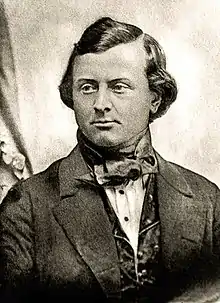Carl Bergmann | |
|---|---|
 | |
| Born | Karl Georg Lucas Christian Bergmann 18 May 1814 |
| Died | 30 April 1865 (aged 50) |
| Alma mater | University of Göttingen |
| Known for | "Bergmann's rule" |
| Scientific career | |
| Fields | Anatomy, physiology |
Carl Georg Lucas Christian Bergmann (18 May 1814 – 30 April 1865) was a German anatomist, physiologist and biologist who developed Bergmann's rule relating population sizes to ambient temperature.[1] He also worked on how the retina works with light to produce vision.[2]
Biography
In 1838 Bergmann received his medical doctorate at the University of Göttingen, and later on, served as Obermedicinalrath and as a professor of anatomy and physiology at the University of Rostock. He produced a series of papers between 1839 and 1862 on comparative anatomy in Johannes Peter Müller's Archiv für Anatomie, Physiologie und wissenschaftliche Medicin.[3]
He obtained his habilitation at the University of Göttingen and was named an associate professor in 1843. From October 1852 he was a full professor and a member of the Medicinal Commission in Rostock. In 1861 he was appointed Obermedicinalrath. He died in Geneva on 30 April 1865, following his return from Menton, where he had resided for the winter because of his deteriorating health.[3]
Research
Neuroscience
Bergmann discovered how light receptors in the retina are responsible for producing vision. In the same year, Heinrich Müller arrived at the same conclusion based on physiological evidence obtained using the principle of motion parallax.[4][5]
Quotation
"The fovea centralis, located in the middle of the most acute part of the retina, is, of course, not a blind spot. Rather, as an unusually constructed part located here, it can be assumed to be particularly advantageous. In fact, it is only those retinal elements present here that can be assumed to be percipient."[2]: 249
Publications
- Bergmann, C. (1846). Lehrbuch der Medicina Forensis für Juristen. Friedrich Vieweg und Sohn, Braunschweig
- Bergmann, C. (1848). Über die Verhältnisse der Wärmeökonomie der Thiere zu ihrer Grösse . Vandenhoeck und Ruprecht, Göttingen.
- Bergmann, C. and R. Leuckart (1855). Anatomisch-physiologische Uebersicht des Thierreichs. Vergleichende Anatomie und Physiologie. J. B. Müller, Stuttgart.
- Bergmann, C. (1854). "Zur Kenntnis des gelben Flecks der Netzhaut." Zeitschrift fur rationelle Medicin 3(1): 245-252.
- Bergmann, C. (1857). "Anatomisches und Physiologisches über die Netzhaut des Auges." Zeitschrift fur rationelle Medicin 3(1): 83-108.
References
- ↑ Bergmann's rule at Who Named It
- 1 2 Thibos, Larry; Lenner, Katharina; Thibos, Cameron (18 Dec 2023). "Carl Bergmann (1814–1865) and the discovery of the anatomical site in the retina where vision is initiated". Journal of the History of the Neurosciences.
- 1 2 Karl Georg Lucas Christian Bergmann at Who Named It
- ↑ Müller, Heinrich (1855). "Über die entoptische Wahrnehmung der Netzhautgefässe, insbesondere als Beweismittel für die Lichtperception durch die nach hinten gelegenen Netzhautelemente". Verhandlungen. Physikalisch-Medizinische Gesellschaft in Würzburg. 5: 411-47.
- ↑ Werner, JS; Gorczynska, I; Spillmann, L (2022). "Heinrich müller (1820-1864) and the entoptic discovery of the site in the retina where vision is initiated". J Hist Neurosci. 31 (1): 64-90.